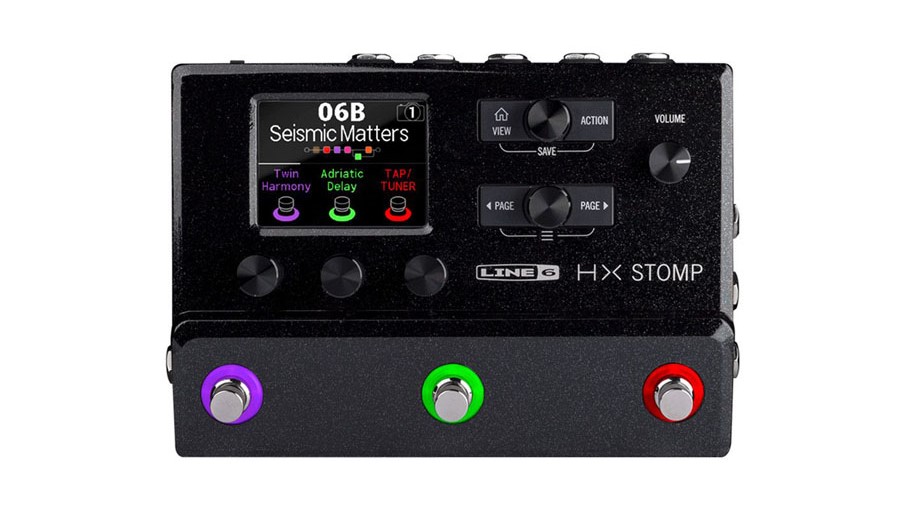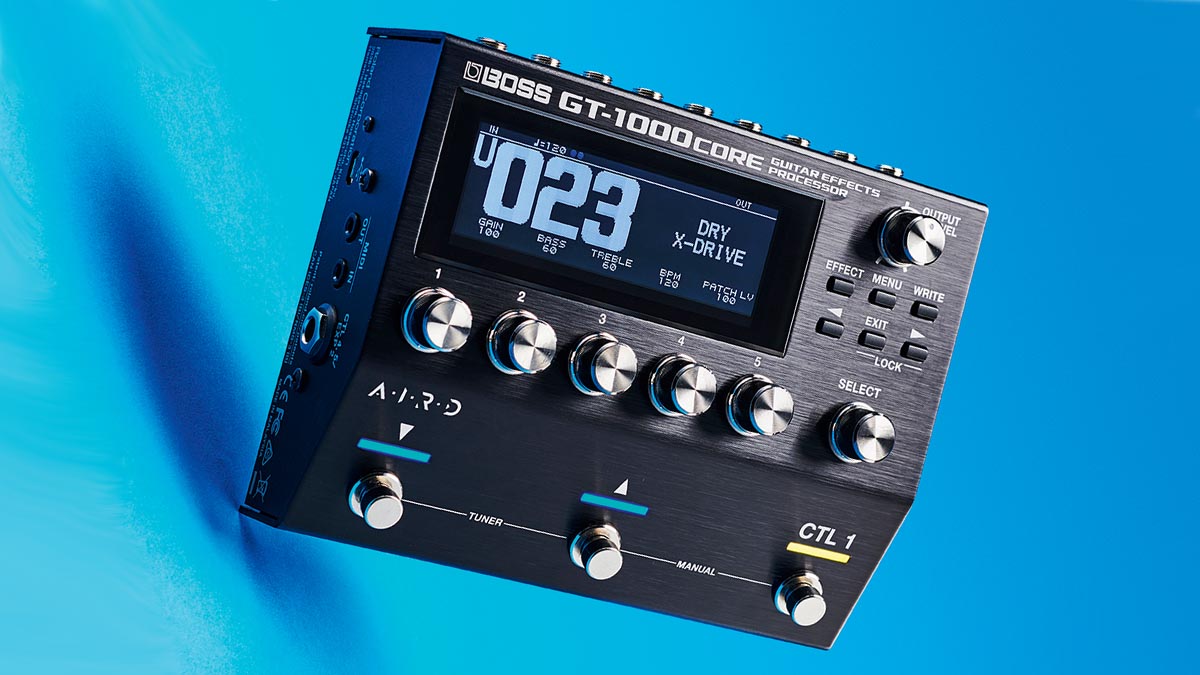MusicRadar Verdict
All the tone-shaping magic of the GT-1000 but smaller and for two-thirds of the price, this super-flexible amp modelling unit is a very convincing option for an all-in-one digital rig, or for dramatically expanding your existing setup.
Pros
- +
Superb range of amp models and effects.
- +
Small footprint.
- +
Two expression pedal inputs.
- +
Two effects loops for adding your favourite stompboxes.
- +
Works as a recording interface.
- +
High-quality 32-bit/96kHz processing.
Cons
- -
Short looping time.
MusicRadar's got your back
What is it?
Launched in 2018, the Boss GT-1000 represented the pinnacle of the Japanese effects titan's multi-effects and amp modelling technology. This was a do-it-all unit, an all-singing, all-dancing solution to compete with the likes of Fractal and Line 6.
It was, or rather, it is a very cool, high-end piece of tech. But not every player wants a floorboard unit, and with that in mind, Boss has taken the DSP brains of the GT-1000 – all its immense 32-bit/96kHz processing power, amp models and patches – and placed them in a compact stompbox-sized unit, the GT-1000 Core.
Sharing the same roadworthy build as its larger sibling, the GT-1000 Core has three main footswitches, a set of five soft knobs for instant editing, a nice and clear display, plus a set of six buttons, output and select controls. You can easily toggle between Memory mode and Manual by pressing down on the middle and CTL 1 (right) footswitch simultaneously.
Of course, this being a smaller unit, you don't have the built-in expression pedal treadle, but you'll find an expression pedal input on the rear of the GT-1000 Core, alongside two effects loops and stereo inputs and outputs. There is an additional expression pedal input on the side of the unit, plus MIDI inputs and outputs and a USB powered. All this is powered by the bundled Boss PSB-1U 9V DC supply.

The amps and effects models are arranged similarly to the GT-1000. You've got 250 presets and 250 user patches, and these are constructed from 24 effects blocks. Boss gives you plenty of options here. You can combine two amp models in one patch, plus a complex chain of effects.
There are over 100 effects to choose from so filling those 24 effects blocks should not be a problem. As you might expect, all the classics from the Boss canon are included, and there is no shortage of modelled stompbox emulations should you need a Fuzz Face or Tube Screamer tone.
Alternatively, you can add your own real-life pedals via the aforementioned effects loops, building an entire rig around the unit. For convenience, these can then be controlled via the GT-1000 Core's footswitches.
Want all the hottest music and gear news, reviews, deals, features and more, direct to your inbox? Sign up here.

Deep editing is intuitive enough once you get your head around the patches setup, but the free Boss Tone Studio will really turn you loose on those edits. You'll soon get the hang of it and start compiling sounds that can be easily recalled.
As with the effects, you've got a veritable bounty of Boss and Roland amps plus a wide array of popular amp models. Convenience allied to the quality of tones is what Boss is going for here. If you want to A/B between a clean Fender-esque combo tone and the midrange punch of an overdriven Marshall, it's all here at the touch of a footswitch.
While you would be forgiven for having option paralysis already, there is more. You can complement the onboard cab sims by uploading your own impulse responses to 16 storage slots. And there you have it: nose-to-tail signal processing. But how does this all stack up in practice?
Performance and verdict
What Boss has done here is not too dissimilar to what Line 6 did to its Helix units with the Helix Stomp, or indeed the HeadRush Gigboard. The essence of the unit remains the same. There's no truck with the quality of the amp models here. How it functions as a performance tool is crucial as to whether the scaled-down format works.
With seven fewer footswitches to choose from, you need to do a little thinking as to how you want them to work. Boss helpfully allows you to assign functions for them, and as mentioned above, toggling between Manual and Memory modes is quick and easy. You can set the GT-1000 Core up so that the footswitches have momentary or latching modes – the former handy for holding sustain down on a reverb for creating a wash of ambience as the song requires it.
In Memory mode, the first two footswitches are browsing and selecting the stored patches, while the CTL 1 knob can be given a specific purpose in the patch, such as a boost, overdrive or perhaps a tap-tempo for a time-sensitive effect.

• Line 6 HX Stomp
It's not as flexible on-the-fly as its larger forebears, but the HX Stomp offers a staggering number of tones from a pedalboard-friendly package.
• Fractal Audio Systems FM3
Compact and portable but packing enough functionality for the gigging musician to use it as an all-in-one rig, the FM3 is another exceptional offering from Fractal.
• HeadRush Gigboard
One of the most intuitive multi-effects pedals yet, with a superb array of amp models.
Manual mode operates a little differently. Here you can set up different patches and assign functions to footswitches that pertinent to that patch. Effectively, you could program a patch, assign the footswitch effects that it could turn on and off again, and build your sound that way.
For example, you could set the patch so you have your core sound, assign a boost to one switch, a delay to another, and maybe some fuzz for when a solo comes around. That mode might be better for you if you save the patches as songs in your setlist. Simply load up a patch for the song – effectively a whole new programmed pedalboard – and use those footswitches if you need to change effects mid-song.
In Memory mode, simply switch from patch to patch. The transition is seamless. You can also carry over the delay and reverb effects as you go.

With all fully functioned amp modellers and multi-effects, it takes a little getting used to. Not so much in terms of operating the unit, which is intuitive enough, but working out how to configure it best to your needs – and of course setting aside some hours so that you can fall happily down that rabbit hole chasing tones.
With the GT-1000 Core, the sky's the limit. We mentioned A/Bing between distinct amp voices, but this is really about having the capability to dial in almost any sound you can imagine. The sonically adventurous will be rewarded for their experimentation.
You could get more than your money's worth even if you just wished to the GT-1000 Core as simply a multi-effects unit with some bells and whistles, but it also functions as a 6-in/6-out USB audio interface, making it a very useful piece of kit to have around the house, not just for tracking but for re-amping too.

Just think what you can do with all those amp models, effects and cab sims. It then becomes a very powerful home production tool when used in that context. The GT-1000 Core's domestication is further enhanced by a headphone out, with the cab sims making silent practice a musically rewarding experience rather than the dry affair you'd get from a non-emulated headphones output.
Other useful little tools include a 38-second mono looper, tuner, and metronome. All this, and you can throw it in a backpack and use it as a fly rig to go straight into a PA system. We guitarists should never take it for granted that we can have such tone-shaping power and functionality from such a small unit. The price is not bad either.
MusicRadar verdict: All the tone-shaping magic of the GT-1000 but smaller and for two-thirds of the price, this super-flexible amp modelling unit is a very convincing option for an all-in-one digital rig or for dramatically expanding what you have.

The web says
“Using the GT-1000CORE is enjoyable. We love the display, even if we still favour the USB cable and desktop software for those long editing sessions. But if you’re worried about connectivity and the organisation of switches, you might want to look at the full-scale GT-1000 instead.“
MusicTech
“The Boss GT‑1000 is an impressive, well‑priced combination of guitar amplifier/effect modelling floorboard, audio interface and MIDI controller that is capable of delivering an impressive level of performance. Its amplifier models are effective and sound good and its effects capabilities are huge. In terms of the playing experience, the GT‑1000 feels every bit as good as its direct competitors and, overall, it offers impressive value for money.“
Sound On Sound
“The GT-1000CORE is effectively the stompbox collection of a Boss fanatic's dream – all packed into one very compact, practical, and user-friendly box, with a ton of bonus features for flexible connectivity, editing, studio-quality processing, recording, and performance. It's quite an achievement for the price and size.“
Premier Guitar
Hands-on demos
Nita Strauss
Rabea Massaad
Andertons
Premier Guitar
Specifications
- ORIGIN: Malaysia
- TYPE: Amp and Effects modelling floor/ desktop unit
- FEATURES: 250 user and 250 preset patches, 38 second phrase looper (19 in stereo), 6 in / 6 out USB audio interface, software editor with USB connection, mono or polyphonic tuner, metronome, IR loading capability
- CONTROLS: Output Level, Select, footswitches x 3, soft knobs x 5 (1, 2, 3, 4, 5), Select knob, buttons x 6
- CONNECTIONS: Standard inputs (R/Mono, L), Standard outputs (R/Mono, L/Phones), Standard Sends 1 and 2, Standard Returns 1 and 2, CTL 2, 3/EXP1, CTL 4, 5/EXP2, MIDI In, MIDI Out, USB
- POWER: Supplied PSB-1U power adapter (9V 2A)
- DIMENSIONS: 173 (w) x 135 (d) x 65 mm (h)
- CONTACT: Boss
MusicRadar is the number one website for music-makers of all kinds, be they guitarists, drummers, keyboard players, DJs or producers...
- GEAR: We help musicians find the best gear with top-ranking gear round-ups and high-quality, authoritative reviews by a wide team of highly experienced experts.
- TIPS: We also provide tuition, from bite-sized tips to advanced work-outs and guidance from recognised musicians and stars.
- STARS: We talk to musicians and stars about their creative processes, and the nuts and bolts of their gear and technique. We give fans an insight into the craft of music-making that no other music website can.

